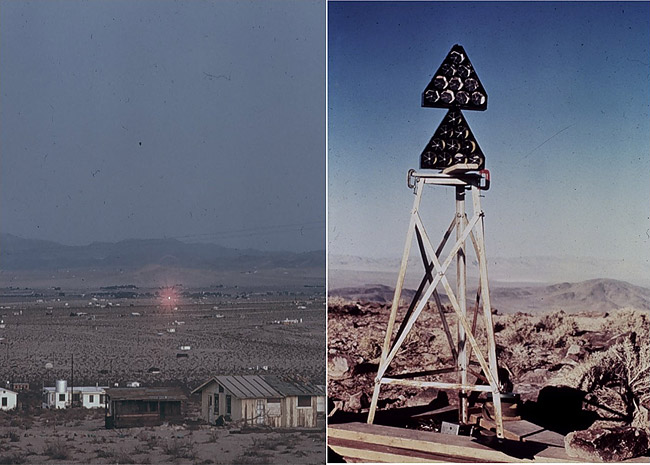 Great Theodolite
Great Theodolite The Bache- Wurdemann Compensating Device
The Bache- Wurdemann Compensating Device Eimbeck Duplex Bars
Eimbeck Duplex Bars Iced Bar B 17
Iced Bar B 17 Steel Tape with Tape Stretcher
Steel Tape with Tape Stretcher Invar Tape
Invar Tape AGA Geodimeter NASM-2A
AGA Geodimeter NASM-2A Tellurometer Model M/RA 1
Tellurometer Model M/RA 1 Laser Signal and Prismatic Mirror Reflecting System
Laser Signal and Prismatic Mirror Reflecting System AGA Geodimeters, Models 4D and 4L
AGA Geodimeters, Models 4D and 4L Big Red
Big Red AGA Geodimeter Model 6
AGA Geodimeter Model 6 Hewlett-Packard Model 3800B Distance Meter
Hewlett-Packard Model 3800B Distance Meter Tellurometer Model MA-100
Tellurometer Model MA-100 Ranger III and Rangemaster III
Ranger III and Rangemaster III Topcon ET-1 Total Station
Topcon ET-1 Total Station Trimble GPS Antenna
Trimble GPS Antenna
Laser Signal and Prismatic Mirror Reflecting System
A key component of an electronic distance measurement instrument is the reflector system, which bounces light signals of a known wavelength to a reflector to determine distance. The prism system shown in this photograph was one of the later systems used in Geodimeters.

These images show the laser signal and prism reflector system used by the Transcontinental Traverse party of Woodrow Johnson.
A major part of any electronic distance measurement instrument (EDMI) is the reflector that returns a beam of light back to an instrument. The wavelength of the returning light signal is compared to the outgoing one, and the difference (called the "phase shift") is measured. Using multiple frequences of light, the instrument computes a distance based on the known lengths and measured phase shifts of returning light waves. Over the evolution of EDMI, the types of reflector systems used have evolved. Initially, Swedish physicist Erik Bergstrand, inventor of the Geodimeter, used a plane mirror as a reflector, then a spherical mirror, and then a prism system.
Former agency director Lewis Lapine remembers what it took to get a return signal when the two available types of long-distance, laser-based instruments were used on his field party in the early 1970s: "Both instruments required a prism per kilometer of distance. One night in Massachusetts, we posted 64 prisms. It took three of us to move it from one hole to another on the offset bar. Remember, a prism holder had up to 16 prisms."
Historic Reference
As can be seen by the terrain in the image, no longer were weeks spent searching for, clearing, and grading a site for a long, straight line that had no more than a five-percent slope. No longer were mile, after mile of supports or a comparator to maintain tape or rod standardization built. EDMI were expensive, and they and their reflector systems required some effort, but they quickly paid for themselves.
- Distance Measurement Instrument Shown: Laser signal and prismatic mirror reflecting system
- Location: Mojave Desert, California
- Manufacture Date: 1970s
- Dates of Use: 1970s
- Photo Date: 1972
Works Consulted
Brinker, R. C., Wolf, P. R. (1977). Elementary Surveying. New York, NY: Harper & Row Publishers, Inc.
Smith, J. R. (1983). Geodimeter 1947-1983. Unpublished.
